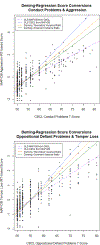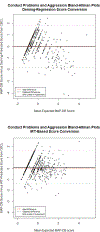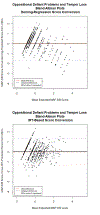Linking the Child Behavior Checklist (CBCL) with the Multidimensional Assessment Profile of Disruptive Behavior (MAP-DB): Advancing a dimensional spectrum approach to disruptive behavior
- PMID: 31452592
- PMCID: PMC6709983
- DOI: 10.1007/s10826-018-1272-4
Linking the Child Behavior Checklist (CBCL) with the Multidimensional Assessment Profile of Disruptive Behavior (MAP-DB): Advancing a dimensional spectrum approach to disruptive behavior
Abstract
Disruptive behavior in childhood is common. It spans from normative child misbehaviors to clinically-significant and impairing problems. While there are many rating scales evaluating such behaviors, historically, measurement has emphasized counting the number of symptoms present rather than assessing the normal-abnormal spectrum of behavioral expression. This study uses data from 644 early school age children aggregated from two data sources to statistically link a commonly used symptom count measure, the Child Behavior Checklist (CBCL), to a more developmentally-sensitive measure, the Multidimensional Assessment Profile of Disruptive Behavior (MAP-DB). Two links between conceptually similar scales on each measure were developed: CBCL Conduct Problems and MAP-DB Aggression; and CBCL Oppositional Defiant Problems and MAP-DB Temper Loss. We compared two innovative methods-Item Response Theory (IRT) and Deming regression-to determine the optimal linking relationship. Results suggest IRT methods were superior in reducing linking error compared to Deming regression. While Deming regression accurately modeled the mean scores (thus minimizing linking bias), this method could not adequately address the floor effect for scores on the CBCL. For practical purposes, this study provides a crosswalk of score conversions between the CBCL and MAP-DB, such that data aggregation and group comparisons can be made across the two measures; this enables longitudinal analyses with historically-collected CBCL data to transition to the more innovative dimensional scales of the MAP-DB without undo loss of extant data. This study furthers efforts to shift from historical symptom counts to more developmentally-sensitive measurement across the disruptive behaviors spectrum.
Keywords: Assessment; CBCL; Deming Regression; Developmental psychopathology; Disruptive Behavior; Item Response Theory; Linking; MAP-DB.
Conflict of interest statement
Conflict of Interest: The authors declare that they have no conflict of interest.
Figures



References
-
- Achenbach TM, Conners CK, Quay HC, Verhulst FC, & Howell CT (1989). Replication of empirically derived syndromes as a basis for taxonomy of child/adolescent psychopathology. Journal of Abnormal Child Psychology, 17, 299–323. - PubMed
-
- Achenbach TM, & Ruffle TM (2000). The Child Behavior Checklist and related forms for assessing behavioral/emotional problems and competencies. Pediatrics in Review, 21, 265–271. - PubMed
-
- American Psychiatric Association. (2013). Diagnostic and Statistical Manual of Mental Disorders (DSM-5®) (5th ed.). Washington, DC.
-
- Biedzio D, & Wakschlag LS (in press). Developmental emergence of disruptive behaviors beginning in infancy: Delineating normal:abnormal boundaries to enhance early identification
-
- Bland JM, & Altman D (1986). Statistical methods for assessing agreement between two methods of clinical measurement. The Lancet, 327, 307–310. - PubMed
Grants and funding
LinkOut - more resources
Full Text Sources
Miscellaneous
